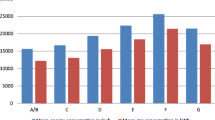Abstract
In the late 1970s and for most of the 1980s, residential energy use in the OECD underwent significant changes. Many of these changes were a result of more efficient energy use in response to higher energy prices, energy efficiency programs, and the appearance of new technologies for saving energy. This study analyzes these changes and the impact of energy use on carbon emissions in the residential sector for nine OECD countries for the period from 1973 to 1992. The major findings of this analysis are:
(i) CO2 emissions per capita were lower in 1992 in almost all of the countries we studied;
(ii) The two primary changes were improvements in energy efficiency and a decrease in the share of fossil fuels used for electricity and district heating production;
(iii) The main source of growth in emissions from residential energy use was increased ownership of electric appliances, where, in spite of important improvements in energy efficiency, ownership grew so rapidly that electricity use (and subsequent emissions) increased;
(iv) Changes in fuel mix, including both the changes in the share of fuels used in households and the share of fuels used to generate electricity and district heating, led to a decrease in emissions in the nine countries;
(v) Increasing the efficiency of electric appliances and further reductions in the intensity of space heating are probably the key elements in a strategy to improve efficiency as a means to lowering CO2 emissions.
Similar content being viewed by others
References
Alliance to Save Energy, American Council for an Energy-Efficient Economy, Natural Resources Defense Council, Union of Concerned Scientists: 1991, America s Energy Choices: Investing in a Strong Economy and a Clean Environment,Cambridge, MA: Union of Concerned Scientists.
Hohmeyer, OO.: 1989, Social Cost of Energy Consumption,Berlin, Germany: Springer-Verlag.
Howarth, R., Schipper, L. J., and Andersson, B.: 1992, The Structure and Intensity of Energy Use: Trends in Five OECD Nations,Berkeley, CA: Lawrence Berkeley Laboratory Report LBL-3243 1.
IPCC (Intergovernmental Panel on Climate Change): 1995, Climate Change 1994: Radiative Forc-ing of Climate Change and An Evaluation of the IPCC IS92 Emission Scenarios,Cambridge: Cambridge University Press.
IEA (International Energy Agency): 1989, Energy Balances of OECD Countries 1970–1985,OECD, Paris.
IEA (International Energy Agency): 1991, EnergyBalances of OECD Countries 1980–1989,OECD, Paris.
Ketoff, A. and Schipper, L. J.: 1990, "Looking Beyond the Aggregate Figures: What Really Happened to Household Energy Conservation," In Vine, E. and D. Crawley (eds.) State of the Art of EnergyEfficiency: FutureDirections,Washington, DC: American Council for an Energy-Efficient Economy.
Larsen, B. and Shah, A.: 1992, World Fossil Fuel Subsidies and Global Carbon Emissions,Policy Research Working Paper Series No. 1002. Washington, DC: The World Bank, Office of the Vice President, Development Economics.
MacKenzie, D.: 1993, "Britian's Fridges: Too Hot to Handle," New Scientist,139 (1889), 14–15, 4 September, 1993.
Magnussen, J. and Brandel, M.: 1991, Energi och Miljoe i Norden,NORD 1991:23. Copenhagen, Denmark: Nordiska Raodet (the Nordic Council).
Marland, G.: 1982, "The Impact of Synthetic Fuels on Global Carbon Emissions," in W. C. Clark ed.Carbon Dioxide Review.Clarendon Press, Oxford 1982.
Marland, G. and Pippen, A.: 1990, "United States Emissions of Carbon Dioxide to the Earth's Atmosphere by Economic Activity," Energy Systems and Policy, 14, 319–336.
Meyers, S.: 1987, "Energy Consumption and Structure of the U.S. Residential Sector: Changes Between 1970 and 1985," Annual Review of Energy,12, 81–97.
Ottinger, R., Robinson, N., Babb, S., Wooley, D., Hodas, D., Buchanan, S., Chemick, P., Caverhill, E., Meltzer, J., Krupnick, A., Harrington, W., and Radin, S.: 1990, EnvironmentalExternalities Costs from Electric Utility Operations, Albany,NY: New York State Energy Research and Development Agency and Washington, DC: U.S. Department of Energy. Available from the American Council for an Energy-Efficient Economy, Washington, DC.
Schipper, L. J., Ketoff, A., and Kahane, A.: 1985, "Explaining Residential Energy Use With International Bottom-up Comparisons," Annual Review of Energy10, 341–405.
Schipper, L. J. and Hawk, D.: 1991, "More Efficient Household Electricity Use: An International Perspective," Energy Policy,19, 244–265.
Schipper, L. J., Steiner, R., Duerr, P., An, E, and Strom, S.: 1991, Energy Use in Passenger Trans-port in OECD Countries: Changes between 1970 and 1987,Berkeley, CA: Lawrence Berkeley Laboratory Report LBL-29831.
Schipper, L. J., Meyers, S., with Howarth, R., and Steiner, R.: 1992a, Energy Efficiency and Human Activity: Past Trends, Future Prospects, ISBN No. 0 52143297 9. Cambridge, U.K.: Cambridge University Press.
Schipper, L. J., Howarth, R., Andersson, B., and Price, L.: 1992b, Energy Use in Denmark: An International Perspective,Berkeley, CA: Lawrence Berkeley Laboratory Report LBL-32362.
Schipper, L. J., Johnson, F., Howarth, R., Andersson, B., Andersson, B., and Price, L.: 1993a, Energy Use in Sweden: An International Perspective,Berkeley, CA: Lawrence Berkeley Laboratory Report LBL-33819.
Schipper, L. J., Howarth, R., Andersson, B., and Price, L.: 1993b, "Energy Use in Denmark: An International Perspective," Natural Resources Forum17(2).
Torvanger, A.: 1991, "Manufacturing Sector Carbon Dioxide Emissions in the OECD Countries, 1973–87: A Divisia Index Decomposition to Changes in Fuel Mix, Emission Coefficients, Industry Structure, Energy Intensities and International Structure," Energy Economics.July 1991.
Tyler, S. and Schipper, L. J.: 1990, "The Dynamics of Electricity Use in Scandinavian Households," Energy-The International Journal, 15(10), 841–863.
U.S. DOE (Department of Energy): 1991, National Energy Strategy: Powerful Ideas for America,Washington, DC: Superintendent of Documents, DOE/S-0082P.
Author information
Authors and Affiliations
Rights and permissions
About this article
Cite this article
Schipper, L.J., Haas, R. & Sheinbaum, C. Recent Trends in Residential Energy Use in OECD Countries and their Impact on Carbon Dioxide Emissions: A Comparative Analysis of the Period 1973–1992. Mitigation and Adaptation Strategies for Global Change 1, 167–196 (1996). https://doi.org/10.1023/B:MITI.0000027384.94103.f2
Issue Date:
DOI: https://doi.org/10.1023/B:MITI.0000027384.94103.f2




